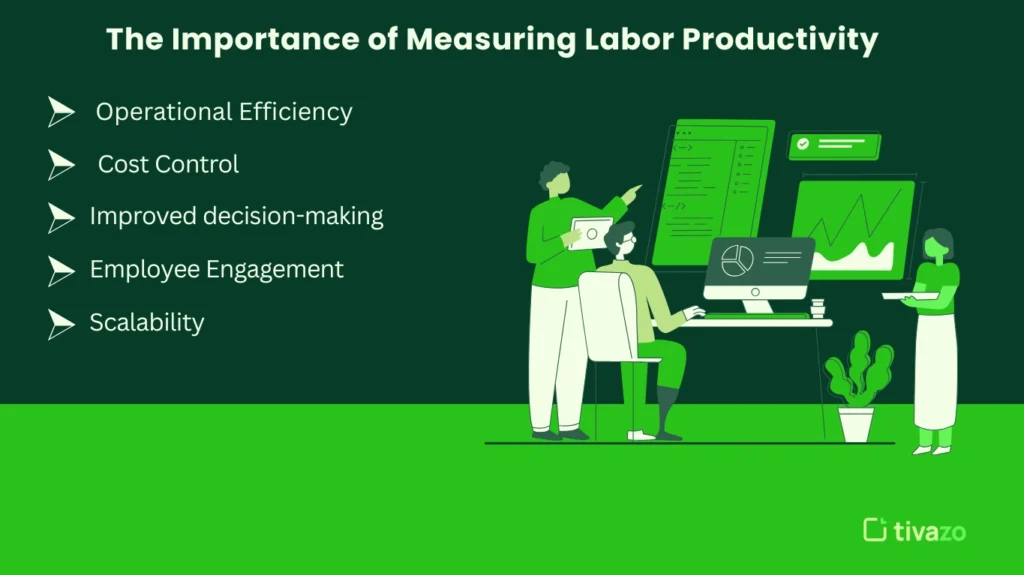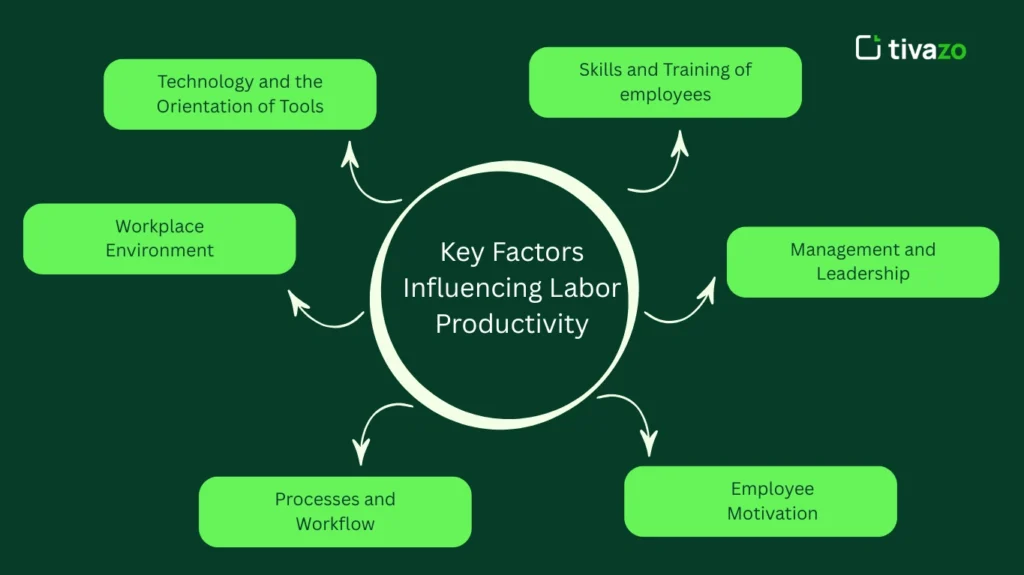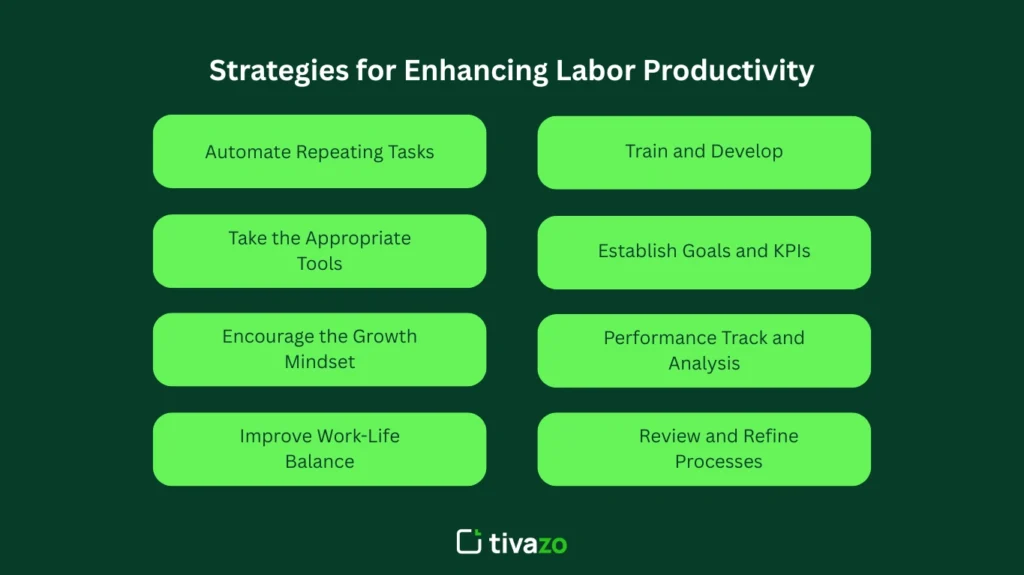“Productivity isn’t everything, but in the long run, it is almost everything.”
— Paul Krugman
This quote incorporates a crucial fact in the business world. The gauge of economic performance and organizational growth is labor productivity, which is measured in terms of output per worker or output per hour worked. Not just a figure with economists or a management hype in boardrooms, it is a pivotal key performance indicator that leads to profitability, innovation, and job satisfaction.
In this blog, we are going to deconstruct what this term of labor productivity actually means, why it is such a big deal, how to actually measure it, and, most importantly, how to enhance it. And we will also demonstrate how contemporary instruments, such as Tivazo, may assist you in monitoring and improving labor productivity with accuracy and comfort.
What Is Labor Productivity?
Labor productivity or workforce productivity is the ratio of the total output of a certain piece of work to the amount of labor input used in that effort (generally within an hour of work or per worker). It gives an indication of the efficiency of a group or organization as a whole and not that of individual workers.
It is worth reminding that labor productivity is a macroeconomic indicator, which is frequently used to compare the efficiency on the national or industry level. It is not to be confused with employee productivity, which is concerned with the performance of individual employees. Although the two are indicators of productivity, labor productivity focuses on the efforts made by the entire labor force of a nation to economic production.
A Note on Labor Laws
On the way to measuring labor productivity, one of the aspects that should not be overlooked is the framework of labor laws, which are the legal parameters that define the working hours, wages, health and safety, worker rights, and workplace conditions. These laws are meant to safeguard the workers and treat them fairly, and it has a direct effect on the productivity of labour since it dictate the limit within which businesses can work. As another example, excessively long working hours may result in higher short-term production but lower productivity of labor overall as it results in burnout or turnover.
The key to sustainable growth and an ethically run business is related to the balance between achieving productivity goals and compliance with labor laws.
Formula:
Labor Productivity = Total Output / Total Labor Input (in hours or number of workers)
As an example, assume that your team delivers one million dollars worth of services in 1,000 hours then, your labor productivity becomes 100,000/1,000 = 100/hour.
It is not only the speed at which labor is being performed but the amount of value created in relation to the input, and this is the nut of labor productivity.
What are the Importance of Measuring Labor Productivity?

Knowing and managing labor productivity has concrete, strategic value since it touches every area of your business decisions, including daily operations and long-term growth. This is why you cannot afford to disregard it as a metric:
1. Operational Efficiency
High labor productivity implies that your team will be able to do more work within a shorter duration of time, and do not have to compromise their quality. This performance enables you to maximize your resources, minimise pumping processes, and lessen redundancies in operations. You are not going to hire more individuals or invest in additional equipment, but use what you have to the maximum and reduce losses and increase production.
2. Cost Control
Increased workforce efficiency is a direct contribution to reduced labor expenses per unit of output. When you make more out of equal work input, your cost-efficiency rises and you can maximize your profits, all without having to resort to lay-offs or reduction of the number of workers employed. It particularly comes in handy in competitive industries where the profit margins are thin.
3. Improved decision making.
By regularly measuring the productivity of labor, you will have an objective picture of the workflow based on data on departments and projects. Such transparency allows managers to recognize where they have not performed well, have bottlenecks, or wasted talent. This understanding will enable leaders to make decisions quickly and more intelligently, i.e., through reallocation of resources, changing workloads, or adding new tools to enhance output.
4. Employee Engagement
Fair and open evaluation of labor productivity can empower employees. Knowing that they are being subjected to an objective evaluation of their contribution to their organization makes the individuals feel more responsible and involved. The establishment of clear performance expectations and the monitoring of the same over a period of time generates a feeling of ownership, promotes a healthy competition, and gets people motivated to achieve a high level of productivity.
5. Scalability
Companies that measure and optimize labor productivity have a greater potential for scaling. Why? They are already so efficient, responsible, and flexible that they developed a culture of that. When there are mechanisms to monitor your work and optimize processes, scaling becomes easier; it can be achieved through hiring or entering into new markets, or producing more and with a higher level of sustainability.
Key Factors Influencing Labor Productivity

The definition of labor productivity depends on various internal and external factors that influence the performance of the work. Being aware of these aspects enables companies to implement changes that can result in long-term benefits.
1. Technology and the Orientation of Tools
The availability of the correct digital equipment can revolutionize the work of a team. Automation systems such as Tivazo minimize the weight of repeated administrative processes such as time-keeping, reporting and attendance. Technology contributes to the increase in output without adding work by assimilating real-time monitoring and analysis which enables a team to be engaged in high-value work.
2. Skills and Training of employees
A highly skilled labor force equals a productive labor force. When employees are correctly onboarded, regularly upskilled, and trained to a higher level of skill, they will do the job much quicker and reduce the level of errors incurred. Employee learning will make them adaptive, creative, and competent with the environment’s latest requirements, increasing the performance of the individual and the team.
3. Workplace Environment
Psychological and physical comfort have a great effect on the manner in which individuals can work. Concentration and creativity are helped by clean, safe, well-lit surroundings and hindered by noise, clutter, or dangerous surroundings. Also, group culture or a collaborative work environment where the workers are respected and listened to enhances interaction and more output.
4. Management and Leadership
It is said that good leadership is critical to the productivity of labor. Good managers establish expectations, match assignments with group strengths, give feedback at the right time, and remove barriers that slow down processes. Clear channels of communication and friendly management keep the employees on the right track and make them feel appreciated, hence leading to steady output.
5. Processes and Workflow
Effective processes decrease misunderstanding, cut down on redundancies, and increase the pace of doing tasks. Standard operating procedures (SOPs), clear responsibilities, and up-to-date workflow tools assist teams to concentrate on the work but not on coordination. With everyone having the idea of what, when, and how to do something, the amount of work output automatically increases.
6. Employee Motivation
Employees who are motivated to work more, are creative, and highly committed. Such measures as bonuses, public recognition, opportunities to develop their careers, and a sense of purpose directly affect the output level. Employees will put in extra effort when they feel that what they do counts and is appreciated. In other words, they will always push the limits of what they can encompass.
Strategies for Enhancing Labor Productivity

Enhancing labor productivity is not a quick solution but a long-term effort that requires strategic planning, frequent checks as well as appropriate tools. Eight effective and viable tips on ways through which organizations can improve the productivity of their workforce could be summarized as below:
1. Automate Repeating Tasks
Automation is able to considerably raise productivity because it takes out of the task even the most monotonous jobs that somebody can perform by hand. There are tools such as Tivazo that enable the automation of time management, attendance, notifications, and reports. This relieves time off their hands so that employees can engage in high-impact work to make more output without straining.
2. Train and Develop
An efficient employee force is an effective workforce. Having regular training means that the employees will remain at speed with the current tools, techniques, and best practices. Training also minimizes mistakes, enhances confidence, and enables teams to work on their tasks in a more efficient way.
3. Take the Appropriate Tools
It is necessary to provide teams with appropriate collaborative and operational digital tools in order to work together better and more efficiently. It is suggested that the following should be used:
- Project Management: Asana, Trello, ClickUp
- Time Tracking and Monitoring: Tivazo
- Communication tools: Slack, Google Meet
- Collaboration Suites: Notion, Google Workspace
A combination of tools in the right proportion reduces the production of friction and increases the output, working at any level.
4. Establish Goals and KPIs
The definition of certain goals, performance indicators will allow structuring teams to achieve the goals of the organization. Apply the SMART goal model, specific, measurable, achievable, relevant, and time-bound, so that the goals can be done and followed. Accountability is achieved with clear targets, and everyone is focused.
5. Encourage the Growth Mindset
Promoting a growth mindset assists in developing a culture of reinforcement. Employees who are open-minded to learn, change, and accepting confrontations are more innovative and robust. This kind of long-term outlook has helped in recording consistent growth in labor productivity.
6. Performance Track and Analysis
Frequent tracking of the performance gives an idea of how resources and time are being spent. The platforms, such as Tivaz,o provide in-depth analytics showing:
- Long-term productivity trends
- Hours devoted to certain activities (or tasks) or projects
- Possibility of overworking or wastage in teams
Evidence-based actions assist in finding the best way of working and increasing output without wild shots.
7. Improve Work-Life Balance
Overworking employees can lead to burnout, absenteeism, and reduced efficiency. Supporting flexible work arrangements, encouraging regular breaks, and fostering a culture of health and wellness can improve focus, morale, and output. A well-rested team is a productive team.
8. Review and Refine Processes
Outdated or inefficient workflows can hinder productivity. Regularly review internal processes to identify redundancies, simplify procedures, and eliminate unnecessary steps. Streamlined workflows enable faster execution and reduce time lost in miscommunication or approvals.
Measure and Improve Labor Productivity with Tivazo
Monitoring the level of labor productivity is ready and could require a lot of time and errors. It is then that Tivazo comes in.
So, what is the point of Tivazo on labor productivity?
- Real-Time Activity Tracking: See who is doing what and as efficiently as possible.
- Screenshot Monitoring: Make things accountable and transparent.
- Elaborated Performance Reports: Create productivity reports that create wiser decisions.
- Attendance and Working Hour Management: Stop wasting time and reducing human error.
- Scalable and Friendly to use: your team can scale with Tivazo, whether your number of employees is 5 or 500.
- Free Forever up to 10: Small teams can increase the productivity of work workforce without any expenses.
Final Thoughts
Being a strategic tool, labor productivity is more than its measure. It affects your bottom line, forms your company culture and dictates what your rate of scaling is. The need to enhance the productivity of labor cannot be wished away, especially in a place where there is growing competition.
So what is the good news? It is not something you have to do by yourself.
When you have such a powerful and comprehensive platform as Tivazo you are able to measure, control, and maximize the potential of your team all at one dashboard. Begin by making minor projects and monitor regularly, and grow more intelligently.




